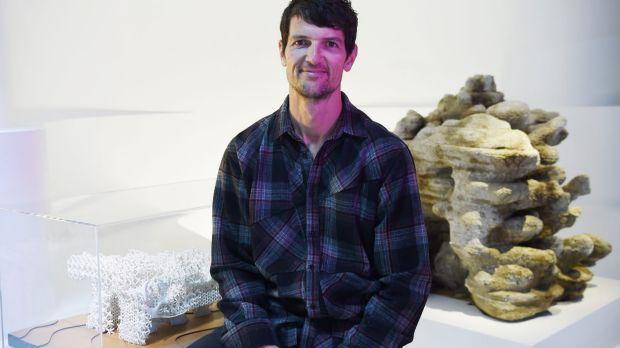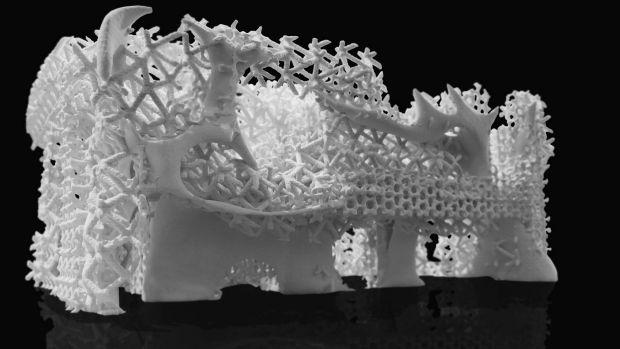
Diagram of the FreeFAB process: (1) wax is printed; (2) wax is CNC milled; (3) wax is poured into mold to create (4) concrete slab; (5) wax is recycled.
If you’re not familiar with Dr. James Gardiner, that’s likely to change soon. The Australian architect is gearing up to change the world through 3D printing, revolutionizing everything from skyscrapers to coral reefs. The nature of 3D printing tends to make everyone think big, but Dr. Gardiner thinks even bigger than most. His employer, Laing O’Rourke, is getting ready to unveil a 3D printer that will dwarf all others – and it owes a lot to Dr. Gardiner’s research and innovation.
Giant 3D printers are showing up everywhere these days as construction begins to shift towards digital design and 3D printed buildings begin to pop up around the world. The nearly 40-foot-tall BigDelta printer from WASP comes immediately to mind as it busily works away at the construction of the world’s first 3D printed village, but the 3D printing technology Laing O’Rourke is developing is quite different from the other methods of constructing 3D printed buildings we’ve seen so far.
The patented FreeFAB 3D printing technology earned Laing O’Rourke a spot on the BRW (now AFR) 50 Most Innovative Companies List in 2014 – the first time a construction company made the list. The FreeFAB team, led by Dr. Gardiner, is gearing up to begin a number of large-scale construction projects using the system, which combines 3D printing, CNC machining, and wax casting in a unique process that allows for the rapid construction of unconventional forms.The FreeFAB process involves a 100 x 25 x 15 ft. 3D printer, which prints large amounts of a wax material at high speed. The wax is then milled by a five-axis CNC machine to create a mold surface of 20-micron accuracy; once the wax mold is finished, concrete is poured in to create a prefabricated building component with intricate design. The large size of the printer allows for the creation of several molds simultaneously in up to three separate cells. Unlike traditional, mass-produced prefabricated concrete components, the FreeFAB technique allows for the manufacture of unique, creative pieces that aren’t feasible with other manufacturing methods due to time and cost constraints.
“Using 3D-printed wax moulds for concrete components, we will have a completely different paradigm. This is transformative technology,” said Dr. Gardiner. “With 3D-printed architectural components we can incorporate aesthetic, structural, acoustic, thermal into a single design. It will bring meaningful change into the construction industry. A process that would have taken days or weeks can be a two-hour process. And we recycle all our materials.”
That’s the key to the dramatic reduction in cost – once a concrete piece has been cast, the wax mold can be easily melted and re-used, meaning that a mold can be used for a single piece and still be cost-effective. The technology is in the final stages of industrialization, with commercial production slated to begin soon on a major construction project in the United Kingdom.
While Dr. Gardiner is leading the FreeFAB Wax Project, he’s still somehow found time to focus on his other area of interest – 3D printed reefs. Several researchers and organizations have been exploring 3D printing as a way to restore dying coral reefs, but the first-ever 3D printed reef, now residing in the ocean off the coast of Bahrain, was the work of Dr. Gardiner and David Lennon of Reef Design Lab. While synthetic reefs are still more commonly made from prefabricated steel and concrete due to cost, they tend to be less effective, as they lack the surface texture of natural reefs and sometimes cause marine life to fall off rather than firmly embedding itself.
“Most artificial reefs use simple, cheap materials that are simplistic and homogenous. They are not well suited for their purpose,” Dr. Gardiner said. “Real reef assemblage is complex and multifunctional.”
“What I loved and was excited about was that James’ 3D-printed reefs allowed for a more organic and natural structure,” added Lennon. “The complexity of structure in a reef relates to the species diversity. But these structures aren’t just good for the fish and coral, the aesthetics of it are good for tourism, too.”
Several of Dr. Gardiner’s 3D printed reef designs are currently on display at the Powerhouse Museum in New South Wales. The exhibit, “Out of Hand: Materialising the Digital,” features work from more than 60 artists, designers and architects from around the world and examines the role of 3D printing in design, along with other digital technologies such as CNC machining, laser cutting, and digital knitting and weaving. The exhibition runs until June 25, 2017. Discuss further in the Gardiner & 3D Printing forum over at 3DPB.com.
[Source: The Sydney Morning Herald]Subscribe to Our Email Newsletter
Stay up-to-date on all the latest news from the 3D printing industry and receive information and offers from third party vendors.
You May Also Like
3D Printing Unpeeled: New Arkema Material for HP, Saddle and Macro MEMS
A new Arkema material for MJF is said to reduce costs per part by up to 25% and have an 85% reusability ratio. HP 3D HR PA 12 S has been...
3D Printing News Briefs, January 20, 2024: FDM, LPBF, Underwater 3D Printer, Racing, & More
We’re starting off with a process certification in today’s 3D Printing News Briefs, and then moving on to research about solute trapping, laser powder bed fusion, and then moving on...
3D Printing Webinar and Event Roundup: December 3, 2023
We’ve got plenty of events and webinars coming up for you this week! Quickparts is having a Manufacturing Roadshow, America Makes is holding a Member Town Hall, Stratafest makes two...
Formnext 2023 Day Three: Slam Dunk
I’m high—high on trade show. I’ve met numerous new faces and reconnected with old friends, creating an absolutely wonderful atmosphere. The excitement is palpable over several emerging developments. The high...


































